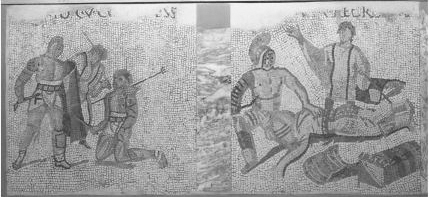Gladiators in Ancient Rome
Posted by MRL on Feb 26th 2024
Ancient Roman mosaic
A slave was bought by an ianista, or head of a gladiator school, and taken to their new master's ludus, the actual school, where their training would begin. Although female gladiators did occasionally exist, the lion's share were men. Freemen could negotiate a contract with an ianista, offering service as a fighter in exchange for money or debt payments. Training was brutal and demanded, discipline harsh and sometimes lethal, and you lived or died by your skill in the arena. Despite this, gladiators were not cruelly treated by their masters as they were a significant investment. They often got to keep their prize money, had a steady diet and place to live, good medical care, received many "pleasures of the flesh," and could even gain their freedom.
Mosaic, Gladiatorial combat scenes, Verona.
It is a common misconception that all gladiator matches ended in death. An enormous effort was put into the training and well being of gladiators so to guarantee a death in every match was impractical. A fighter could signal defeat at any point by raising one finger to seek missio, or the sparring of the gladiator's life. If he had fought well or was a favorite of the crowd he was often sparred. Matches even had a referee to separate the fighters, allow breaks for rest, or even stop the match entirely. This is not to say, however, that the matches were safe. The fights were brutal and frequently resulted in horrible wounds and accidental (or deliberate) deaths which is why most gladiators died in the arena eventually. Despite this, the fame and fortune that came with success in the arena was a powerful allure to freemen and slaves alike.
Mosaic, Gladiators, Mus'ee Saint-Remi `a Reims

After a long, loyal, and successful run, gladiators were occasionally granted freedom and presented a wooden sword, rudis. Although most died long before turning 30, those that gained their freedom could easily have a long and successful life as a trainer, bodyguard, etc. In most cases, however, gladiators were seen as below slaves and kept separate from the citizens. They were even buried in different burial grounds. Gladiator matches were eventually banned in the 4th and 5th century CE and more or less ceased completely with the fall of the Western Roman Empire in 476 CE.
by Alex Smith, MRL staff writer


